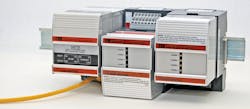Engineering preference for Ethernet as an industrial communication network — be it due to technological reasons or corporate edict — only seems to be picking up speed. Clear evidence of this can seen in the large numbers of updates and new devices coming to market with Ethernet ports built in. I made reference to this while moderating a recent Webcast about the use of Ethernet for machine control.
The newest entry into the Ethernet-ready category comes from Moore Industries-International. In this case, it’s an update to the company’s Net Concentrator System (a process control and distributed I/O network) that offers a new EMM interface module. This new module gives the Net Concentrator System (NCS) an Ethernet (Modbus/TCP) port and dual, independent Modbus RTU (RS-485) ports. One or both of the Modbus RTU ports can be configured as Modbus master ports, allowing the NCS to poll other Modbus RTU slaves with the network polling functions of a typical Modbus master. Prior to this update, the NCS could only act as a Modbus slave. The update allows the NCS to be used as either a single or dual Modbus master, meaning that it can provide simultaneous Ethernet and dual Modbus RTU master/slave communications.
NCS users can now view, select and set operating parameters for both Ethernet and the dual Modbus parameters through the Internet Explorer Web browser or the free Intelligent PC Configuration software from Moore Industries.
The new updates have not impacted the harsh duty capabilities for which the Net Concentrator System is known. The NCS is designed to work in industrial applications with an ambient temperature range of -40°C to +85°C (-40°F to +185°F). In addition, Moore Industries says the 20-bit input and 18-bit output resolution of the NCS matches or exceeds the accuracy of the most precise process transmitters on the market.
Leaders relevant to this article:


